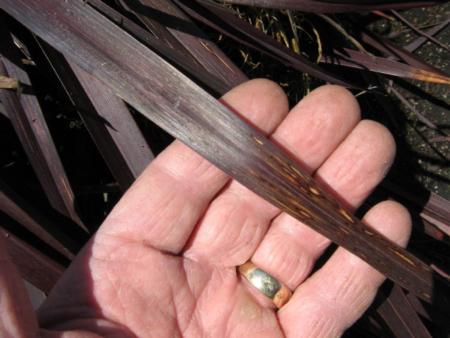Summer 2012: New anthracnose disease on New Zealand flax
Regional Report for Santa Cruz and Monterey Counties by Steve Tjosvold
New Zealand flax and its hybrid cultivars are very important to the ornamental nursery industry locally, in California and the world, as they are becoming a popular component in many new landscapes. An important anthracnose disease was recently found on New Zealand flax (Phormium) in a California Central Coast nursery. The detection of the causal agent, Colletotrichum phormii, on nursery stock was the first time this fungus was found in North America. All symptomatic plants were destroyed by regulatory officials. Foliar symptoms consisted of dark brown lesions with the central portions discolored. These lesions eventually coalesced to form large irregular necrotic areas. In older lesions, black acervuli (spore-containing structures) formed resembling “blackheads.”

Anthracnose caused by Colletotrichium phormii on Phormium hybrid detected for the first time in North America. Photo credit John Kovarik.
Anthracnose is a general group of fungal diseases that cause dark, sunken lesions on leaves, stems, flowers, and fruits. These fungi infect many deciduous and evergreen trees and shrubs and can infect fruits, vegetables and turfgrass. Examples include Colletotrichum, Coniothyrium, Diplodia, Discula, Gloeosporium, Glomerella, Gnomonia, Macrophoma, Marssonina, Phoma, Phyllosticta and Phyllostictina.
There is no study with C. phormii that has determined the complete range of potential hosts. It, like other closely related Collectotrichum species, appears to be attacking host plants within the family of Agavaceae. C. phormii attacks Phormium and possibly Dracaena. C. agave only infects Agave, and C. dracaenophilum is only found on Dracaena (Farr et.al 2006). Given this information, it would be prudent to concentrate monitoring efforts first on Phormium, then on Dracaena, and finally on other genera in the family Agavaceae.
Little is known about the biology of C. phormii. In general, anthracnose fungi need water in order to disseminate and infect, and they don’t spread in dry conditions. Some Colletotrichum species can attack seeds and roots and many survive in plant residue and soil. C. phormii is known to be among the slowest growing of the Colletotrichum species that attack Agavacae. However, locally, nearly all plants of the same cultivar that were found with the disease were found to be symptomatic. Assume that it spreads by splashing rain or sprinklers. Assume that it survives on living plants, plant debris, and maybe seed.
Steven A. Tjosvold
Farm Advisor, Environmental Horticulture
UC Cooperative Extension Santa Cruz County
1432 Freedom Boulevard
Watsonville, CA 95076-2796
(831) 763-8013 phone, (831) 763-8006 fax
satjosvold@ucdavis.edu
http://cesantacruz.ucdavis.edu












